A Review of Autonomous Berthing Technology for Ships
Abstract
:1. Introduction
2. Literature Dataset Analysis
2.1. Keywords
2.2. Development Trends
2.3. Related Technologies
3. Autonomous Berthing
3.1. Sensing Technology
- (1)
- LiDAR
- (2)
- Rangefinders
- (3)
- Cameras
- (4)
- IMU
- (5)
- Electronic Navigational Charts
3.2. Berthing Types
- (1)
- Direct Approach
- (2)
- Stabilisation Outside the Berth
- (3)
- First Off-Berth Calming and then Parallel Berthing
3.3. Control Methods
3.3.1. Neural Networks
- (1)
- Large ships
- (2)
- Small and medium-sized ships
3.3.2. Optimal Control
3.3.3. Fuzzy Control
3.3.4. Adaptive Control
3.3.5. Sliding Mode Control
3.3.6. Other Methods
3.4. Evaluation Methods
4. Assistive Technologies
4.1. Dynamic Collision Avoidance
4.2. Path Planning
4.3. Path Tracking
4.4. Heading Control
4.5. Tug Assistance
4.6. Shore-Based System
5. Existing Challenges
6. Future Prospects
7. Conclusions
Author Contributions
Funding
Institutional Review Board Statement
Informed Consent Statement
Data Availability Statement
Conflicts of Interest
References
- Zhang, S.; Wu, Q.; Liu, J.; He, Y.; Li, S. State-of-the-Art Review and Future Perspectives on Maneuvering Modeling for Automatic Ship Berthing. J. Mar. Sci. Eng. 2023, 11, 1824. [Google Scholar] [CrossRef]
- Guo, F. Research on Automatic Berthing Technology for Intelligent Ships. Master’s Thesis, Dalian Maritime University, Dalian, China, 2022. [Google Scholar]
- Du, Y.Z.; Zhu, Z.J.; Xie, H.W.; Meng, F.B.; L, J. Nonlinear Model Predictive Control for Automatic Berthing of the Underactuated Twin-propeller Twin-Rudder Ship. In Proceedings of the 2021 China Automation Congress (CAC), Beijing, China, 22–24 October 2021; pp. 3543–3548. [Google Scholar]
- Chen, Z.C.; Xue, Q.M.; Luo, K.; Gao, D.J. Research on Automatic Berthing Control of Intelligent Ship Based on Improved LOS Navigation Algorithm. Navig. China 2021, 44, 126–133. [Google Scholar]
- Maniyappan, S.; Umeda, N.; Maki, A.; Akimoto, Y. Effectiveness and mechanism of broaching-to prevention using global optimal control with evolution strategy (CMA-ES). J. Mar. Sci. Technol. 2021, 26, 382–394. [Google Scholar] [CrossRef]
- Wang, S.K.; Jin, H.Z.; Meng, L.W.; Li, G.C. Optimize motion energy of AUV based on LQR control strategy. In Proceedings of the 2016 35th Chinese Control Conference (CCC), Chengdu, China, 27–29 July 2016; pp. 4615–4620. [Google Scholar]
- Kim, K.; Kim, B.; Kim, Y. A Study on the Optimal Tracking Control System Design for Automatic Ship Berthing. J. Korean Soc. Power Syst. Eng. 2018, 22, 72–80. [Google Scholar] [CrossRef]
- Kamil, A.; Allal, A.A.; Melhaoui, Y.; Mansouri, K.; Rachik, M. A comparative analysis of methods related to automatic ship berthing. In Proceedings of the 2019 5th International Conference on Optimization and Applications (ICOA), Kenitra, Morocco, 25–26 April 2019; pp. 1–4. [Google Scholar]
- Bui, V.P.; Kawai, H.; Kim, Y.B.; Lee, K.S. A ship berthing system design with four tug boats. J. Mech. Sci. Technol. 2011, 25, 1257–1264. [Google Scholar] [CrossRef]
- Lee, D.H.; Huynh, T.; Kim, Y.B.; Park, J.S. Motion Control System Design for Barge-Type Surface Ships Using Tugboats. J. Mar. Sci. Eng. 2022, 10, 1413. [Google Scholar] [CrossRef]
- Tran, V.L.; Im, N. A study on ship automatic berthing with assistance of auxiliary devices. Int. J. Nav. Arch. Ocean 2012, 4, 199–210. [Google Scholar] [CrossRef]
- Li, S.; Liu, J.; Negenborn, R.R.; Wu, Q. Automatic Docking for Underactuated Ships Based on Multi-Objective Nonlinear Model Predictive Control. IEEE Access 2020, 8, 70044–70057. [Google Scholar] [CrossRef]
- Liao, Y.L.; Zhang, M.J.; Wan, L. Serret-Frenet frame based on path following control for underactuated unmanned surface vehicles with dynamic uncertainties. J. Cent. South Univ. 2015, 22, 214–223. [Google Scholar] [CrossRef]
- Xue, Y.Z.; Clelland, D.; Lee, B.S.; Han, D.F. Automatic simulation of ship navigation. Ocean Eng. 2011, 38, 2290–2305. [Google Scholar] [CrossRef]
- Higo, Y.; Sakano, M.; Nobe, H.; Hashimoto, H. Development of trajectory-tracking maneuvering system for automatic berthing/unberthing based on double deep Q-network and experimental validation with an actual large ferry. Ocean Eng. 2023, 287, 115750. [Google Scholar] [CrossRef]
- Sawada, R.; Hirata, K.; Kitagawa, Y.; Saito, E.; Ueno, M.; Tanizawa, K.; Fukuto, J. Path following algorithm application to automatic berthing control. J. Mar. Sci. Tech-Jpn. 2021, 26, 541–554. [Google Scholar] [CrossRef]
- Li, C.; Yan, X.P.; Li, S.J.; Liu, J.L.; Ma, F. In Survey on ship autonomous docking methods: Current status and future aspects. In Proceedings of the 2020 30th International Ocean and Polar Engineering Conference (ISOPE), Shanghai, China, 11–16 October 2020; pp. 3733–3739. [Google Scholar]
- Zhang, Q.; Zhang, X.K. A Review of Research on Automatic Berthing Control for Ships. J. Dalian Marit. Univ. 2015, 3, 1–9. [Google Scholar]
- Han, D.; Chen, H.; Song, G.; Yip, T.L.; Wu, B. Mapping the landscape of ship berthing research: A bibliometric analysis and literature review over two decades. Ocean Coast. Manag. 2023, 242, 106730. [Google Scholar] [CrossRef]
- Xie, H.Q. Study of Autonomous Berthing of Ships. Master’s Thesis, Shanghai Jiao Tong University, Shanghai, China, 2020. [Google Scholar]
- Chen, B.X. An overview of the research and development of automated berthing technology. China Water Transp. 2023, 3, 93–95. [Google Scholar]
- Chen, C.; Li, Y. Ship Berthing Information Extraction System Using Three-Dimensional Light Detection and Ranging Data. J. Mar. Sci. Eng. 2021, 9, 747. [Google Scholar] [CrossRef]
- Chen, C.; Li, Y.; Wang, T. Real-time tracking and berthing aid system with occlusion handling based on LiDAR. Ocean Eng. 2023, 288, 115929. [Google Scholar] [CrossRef]
- Chen, C.; Li, Y. Real-time tracking and dynamic berthing information extraction system with 2D LiDAR data. Ocean Eng. 2023, 276, 114181. [Google Scholar] [CrossRef]
- Qi, W.T.; Ying, L.; Chen, C. Spatial state analysis of ship during berthing and unberthing process based on 3D LiDAR. Ocean Eng. 2023, 288, 116067. [Google Scholar]
- Xiong, Y.; Yu, J.J.; Mou, J.M.; Zhang, B.R.; Zhang, J.; Zhu, Q.G. Automatic berthing of ships based on data-driven control. Navig. China 2020, 43, 1–7. [Google Scholar]
- Lu, X.D.; Li, Y.; Xie, M. Preliminary study for motion pose of inshore ships based on point cloud: Estimation of ship berthing angle. Measurement 2023, 214, 112836. [Google Scholar] [CrossRef]
- Ma, S.J. Acquisition of auxiliary information of berthing ships based on shore-based LiDAR. Pearl River Water Transp. 2023, 14, 77–79. [Google Scholar]
- Wang, H.C.; Yin, Y.; Jing, Q.F.; Xiao, F.B.; Cao, Z. A berthing state estimation pipeline based on 3D point cloud scan-matching and berth line fitting. Measurement 2024, 226, 114196. [Google Scholar] [CrossRef]
- Wang, Q.Z.; Zhao, J.W. In Modeling and Error Analysis of Ship Berthing Parameters. In Proceedings of the 2018 IEEE CSAA Guidance, Navigation and Control Conference (CGNCC), Xiamen, China, 10–12 August 2018; pp. 1–5. [Google Scholar]
- Kamolov, A.; Park, S. An IoT-Based Ship Berthing Method Using a Set of Ultrasonic Sensors. Sensors 2019, 19, 5181. [Google Scholar] [CrossRef] [PubMed]
- Kim, H.; Kim, D.; Park, B.; Lee, S. Artificial Intelligence Vision-Based Monitoring System for Ship Berthing. IEEE Access 2020, 8, 227014–227023. [Google Scholar] [CrossRef]
- Cao, Z.Y.; Liu, F.; Sun, Y.Y. An assisted berthing system based on deep learning visual perception. Mar. Electr. Electron. Technol. 2024, 44, 53–57. [Google Scholar]
- Fu, H.; Huang, Y.; Li, W. Ship berthing motion control based on improved Simulation Localization and Mapping algorithm. In Proceedings of the 2021 4th International Symposium on Traffic Transportation and Civil Architecture (ISTTCA), Suzhou, China, 12–14 November 2021; pp. 233–236. [Google Scholar]
- Volden, Ø.; Stahl, A.; Fossen, T.I. Vision-based positioning system for auto-docking of unmanned surface vehicles (USVs). Int. J. Intell. Robot. 2022, 6, 86–103. [Google Scholar] [CrossRef]
- Volden, Ø.; Stahl, A.; Fossen, T.I. Development and Experimental Validation of Visual-Inertial Navigation for Auto-Docking of Unmanned Surface Vehicles. IEEE Access 2023, 11, 45688–45710. [Google Scholar] [CrossRef]
- Xie, H.Q.; Deng, N.M. Deep learning-based 3D perception algorithm for autonomous ship berthing scenarios. Ship Sci. Technol. 2021, 43, 160–164. [Google Scholar]
- Chen, J. Research on Unmanned Ship Berthing Environment Sensing System Based on Vision and LiDAR Fusion. Master’s Thesis, Wuhan University of Technology, Wuhan, China, 2022. [Google Scholar]
- Kim, S.; Jo, H.; Kim, J.; Park, J. Development of an autonomous docking system for autonomous surface vehicles based on symbol recognition. Ocean Eng. 2023, 283, 114753. [Google Scholar] [CrossRef]
- Hu, B. LIDAR-Based Unmanned Vessel Berthing and Unberthing Information Sensing Research. Master’s Thesis, Dalian Maritime University, Dalian, China, 2022. [Google Scholar]
- Ai, S.K.B.L. Research on Monitoring and Scheduling System for Inland Waterway Vessels Based on GPS and Electronic Charts. Ship Sci. Technol. 2018, 40, 142–144. [Google Scholar]
- Lu, H.G.; Yin, Y. Unmanned Vessel Path Planning Based on Electronic Chart Vector Data Modelling. J. Transp. Inf. Saf. 2019, 37, 94–106. [Google Scholar]
- Ma, M.; Gu, N.; Dong, J.W.; Yin, Y.; Han, B.; Peng, Z.H. Unmanned Aerial Vessel Cluster Area Coverage Path Planning Based on Electronic Nautical Charts. Chin. J. Ship Res. 2024, 19, 211–219. [Google Scholar]
- Zhang, Z.J. An investigation of berthing maneuvers with a positive transverse backward blowing furling wind. Mar. Equip. Mater. Mark. 2019, 1, 39–40. [Google Scholar]
- Guo, Z.C. Analyzing the self-propelled berthing and unberthing of small and medium-sized ships. China Water Transp. 2020, 20, 1–2. [Google Scholar]
- Ahmed, Y.A.; Hasegawa, K. Automatic Ship Berthing using Artificial Neural Network Based on Virtual Window Concept in Wind Condition. IFAC Proc. Vol. 2012, 45, 286–291. [Google Scholar] [CrossRef]
- Ahmed, Y.A.; Hasegawa, K. Implementation of Automatic Ship Berthing using Artificial Neural Network for Free Running Experiment. IFAC Proc. Vol. 2013, 46, 25–30. [Google Scholar] [CrossRef]
- Jia, Y.P.; Shen, H.L.; Yin, Y.; Zhang, X.F. Neural network-based simulation of autonomous berthing of unmanned vessels. China Navig. 2021, 44, 107–111. [Google Scholar]
- Guo, F.; Yin, Y. Simulation of autonomous parallel berthing of unmanned vessel based on fuzzy control. Ship Eng. 2022, 44, 38–43. [Google Scholar]
- Yuan, S.Z.; Liu, Z.L.; Zheng, L.H.; Zheng, Y.X. An event-triggered adaptive time-domain MPC-based approach to ship berthing. Control Decis. 2024, 39, 336–344. [Google Scholar]
- Gjarum, V.B.; Rorvik, E.H.; Lekkas, A.M. In Approximating a deep reinforcement learning docking agent using linear model trees. In Proceedings of the 2021 European Control Conference (ECC), Delft, The Netherlands, 29 June–2 July 2021; pp. 1465–1471. [Google Scholar]
- Im, N.; Nguyen, V. Artificial neural network controller for automatic ship berthing using head-up coordinate system. Int. J. Nav. Arch. Ocean 2018, 10, 235–249. [Google Scholar] [CrossRef]
- Ahmed, Y.A.; Hannan, M.A.; Siang, K.H. Artificial Neural Network controller for automatic ship berthing: Challenges and opportunities. Mar. Syst. Ocean Technol. 2020, 15, 217–242. [Google Scholar] [CrossRef]
- Pang, X.B. Analysis of safety factors for berthing of mega ships. Tianjin Navig. 2019, 4, 26–28. [Google Scholar]
- Bai, X.; Liu, D.; Xu, X.; Xiao, Y. Experimental Study of A New Method for Berthing and Disembarking Large Cruise Ships. In Proceedings of the 2021 3rd International Academic Exchange Conference on Science and Technology Innovation (IAECST), Guangzhou, China, 10–12 December 2021; pp. 1275–1282. [Google Scholar]
- Bui, V.P.; Kim, Y.B. Development of Constrained Control Allocation for Ship Berthing by Using Autonomous Tugboats. Int. J. Control Autom. 2011, 9, 1203–1208. [Google Scholar]
- Shuai, Y.H.; Li, G.Y.; Cheng, X.; Skulstad, R.; Xu, J.S.; Liu, H.H.; Zhang, H.X. An efficient neural-network based approach to automatic ship docking. Ocean Eng. 2019, 191, 106514. [Google Scholar] [CrossRef]
- Wang, X.W. Research on Automatic Berthing Motion Control for Large Ships. Master’s Thesis, Wuhan University of Technology, Wuhan, China, 2020. [Google Scholar]
- Jia, Y.P.; Yin, Y.; Zhu, Z.X. Simulation Study on Autonomous Berthing of Unmanned Vessel Based on Berth Coordinates. J. Syst. Simul. 2020, 32, 1910–1917. [Google Scholar]
- Shimizu, S.; Nishihara, K.; Miyauchi, Y.; Wakita, K.; Suyama, R.; Maki, A.; Shirakawa, S. Automatic berthing using supervised learning and reinforcement learning. Ocean Eng. 2022, 265, 112553. [Google Scholar] [CrossRef]
- Li, R.Z. Research on Unmanned Surface Vessel Trajectory Tracking Control Technology Based on Model Predictive Control. Master’s Thesis, Shanghai Ocean University, Shanghai, China, 2022. [Google Scholar]
- Fan, C.; Wróbel, K.; Montewka, J.; Gil, M.; Wan, C.; Zhang, D. A framework to identify factors influencing navigational risk for Maritime Autonomous Surface Ships. Ocean Eng. 2020, 202, 107188. [Google Scholar] [CrossRef]
- Qu, Z.Y. Research on Automatic Berthing Method of Intelligent Ship. Int. Core J. Eng. 2021, 7, 419–424. [Google Scholar]
- Zhang, Q.; Zhang, X.K.; Lin, N.J. Simple Nonlinear Neural Network Controller for Automatic Ship Berthing. Navig. China 2017, 40, 11–15. [Google Scholar]
- Nguyen, V.; Do, V.; Im, N. Development of Automatic Ship Berthing System Using Artificial Neural Network and Distance Measurement System. Int. J. Fuzzy Log. Inte 2018, 18, 41–49. [Google Scholar] [CrossRef]
- Nguyen, V. A Review of automatic berthing systems based on artificial networks for marine ship. Int. J. Civ. Eng. Technol. 2019, 10, 763–769. [Google Scholar]
- Lee, D. Reinforcement Learning-Based Automatic Berthing System. arXiv 2021, arXiv:2112.01879. [Google Scholar]
- Zhang, M.J. Study of Nonlinear Automatic Berthing Control for Underactuated Surface Vessels. Master’s Thesis, Shandong Jiaotong University, Shandong, China, 2021. [Google Scholar]
- Zhao, Y.S.; Wu, T.; Bai, Y.M. Automatic berthing control of ships under unknown time-varying perturbations and dynamic uncertainty of model parameters. J. Shanghai Marit. Univ. 2022, 43, 8–13. [Google Scholar]
- Kamil, A.; Melhaoui, Y.; Mansouri, K.; Rachik, M. Artificial neural network and mathematical modeling of automatic ship berthing. Commun. Math. Biol. Neu 2022, 22, 113. [Google Scholar]
- Wang, K.; Hua, Y.; Huang, L.Z.; Guo, X.; Liu, X.; Ma, Z.M.; Ma, R.Q.; Jiang, X.L. A novel GA-LSTM-based prediction method of ship energy usage based on the characteristics analysis of operational data. Energy 2023, 282, 128910. [Google Scholar] [CrossRef]
- Mizuno, N.; Kuroda, M.; Okazaki, T.; Ohtsu, K. Minimum time ship maneuvering method using neural network and nonlinear model predictive compensator. Control Eng. Pract. 2007, 15, 757–765. [Google Scholar] [CrossRef]
- Okazaki, T.; Ohtsu, K. In A study on ship berthing support system—Minimum time berthing control. In Proceedings of the 2008 IEEE International Conference on Systems, Man and Cybernetics, Singapore, 12–15 October 2008; pp. 1522–1527. [Google Scholar]
- Mizuno, N.; Kakami, H.; Okazaki, T. Parallel Simulation Based Predictive Control Scheme with Application to Approaching Control for Automatic Berthing. IFAC Proc. Vol. 2012, 45, 19–24. [Google Scholar] [CrossRef]
- Mizuno, N.; Uchida, Y.; Okazaki, T. Quasi Real-Time Optimal Control Scheme for Automatic Berthing. IFAC-PapersOnLine 2015, 48, 305–312. [Google Scholar] [CrossRef]
- Mizuno, N.; Kuboshima, R. Implementation and Evaluation of Non-linear Optimal Feedback Control for Ship’s Automatic Berthing by Recurrent Neural Network. IFAC-PapersOnLine 2019, 52, 91–96. [Google Scholar] [CrossRef]
- Mizuno, N.; Koide, T. Application of Reinforcement Learning to Generate Non-linear Optimal Feedback Controller for Ship’s Automatic Berthing System. IFAC-PapersOnLine 2023, 56, 162–168. [Google Scholar] [CrossRef]
- Bui, V.P.A.J. Optimal Control Design for Automatic Ship Berthing by Using Bow and Stern Thrusters. J. Ocean Eng. Technol. 2010, 24, 10–17. [Google Scholar]
- Kayano, J.; Okazaki, T. In A Study on the Ship’s Automatic Berthing Maneuver Using Real-Time Estimation. In Proceedings of the 2020 IEEE International Conference on Systems, Man, and Cybernetics (SMC), Toronto, ON, Canada,, 11–14 October 2020; pp. 1791–1795. [Google Scholar]
- Wang, S.; Sun, Z.; Yuan, Q.; Sun, Z.; Wu, Z.; Hsieh, T. Autonomous piloting and berthing based on Long Short Time Memory neural networks and nonlinear model predictive control algorithm. Ocean Eng. 2022, 264, 112269. [Google Scholar] [CrossRef]
- Han, X.; Zhang, X.K. Tracking control of ship at sea based on MPC with virtual ship bunch under Frenet frame. Ocean Eng. 2022, 247, 110737. [Google Scholar] [CrossRef]
- Esmailian, E.; Farzanegan, B.; Malekizadeh, H.; Ghassemi, H.; Ardestani, M.; Menhaj, M. Control System Design for a Surface Effect Ship by Linear-Quadratic Regulator Method. Nashriyyah-I Muhandisī-I Daryā (Online) 2017, 13, 47–56. [Google Scholar]
- Tian, T. Research on rudder deceleration control system based on robust optimal control. Master’s Thesis, Harbin Engineering University, Harbin, China, 2021. [Google Scholar]
- Rachman, D.M.; Maki, A.; Miyauchi, Y.; Umeda, N. Warm-started semionline trajectory planner for ship’s automatic docking (berthing). Ocean Eng. 2022, 252, 111127. [Google Scholar] [CrossRef]
- Zhu, S.F.; Li, X.Y.; Qu, X.Y.; Liu, Q.; Li, Z.R. LQR Optimal Control of Four-steering Vehicle Based on Particle Swarm Optimization Algorithm. In Proceedings of the 2022 2nd International Conference on Control and Intelligent Robotics, New York, NY, USA, 14 October 2022; pp. 740–745. [Google Scholar]
- Zhang, W.B. Research on Autonomous Berthing Methods for Underactuated Unmanned Aerial Vessels. Master’s Thesis, Harbin Engineering University, Harbin, China, 2017. [Google Scholar]
- Nguyen, V.; Im, N. Automatic Ship Berthing Based on Fuzzy Logic. Int. J. Fuzzy Log. Inte 2019, 19, 163–171. [Google Scholar] [CrossRef]
- Sun, T.; Yin, Y.; Liu, C. Integrated trajectory planning into automatic berthing control of underactuated ship based on fuzzy-backstepping method. Ocean Eng. 2024, 291, 116336. [Google Scholar] [CrossRef]
- Zhang, Q.; Zhu, G.B.; Hu, X. Adaptive neural network auto-berthing control of marine ships. Ocean Eng. 2019, 177, 40–48. [Google Scholar] [CrossRef]
- Xu, H.X.; Zhu, M.F.; Yu, W.Z.; Han, X. Robust adaptive control of automatic berthing for smart ships. J. Huazhong Univ. Sci. Technol. (Nat. Sci. Ed.) 2020, 48, 25–29. [Google Scholar]
- Wang, L.; Li, S.; Liu, J.; Negenborn, R. Ship docking and undocking control with adaptive-mutation beetle swarm prediction algorithm. Ocean Eng. 2022, 251, 111021. [Google Scholar] [CrossRef]
- Liu, Y.; Im, N.; Zhang, Q.; Zhu, G. Adaptive Auto-Berthing Control of Underactuated Vessel Based on Barrier Lyapunov Function. J. Mar. Sci. Eng. 2022, 10, 279. [Google Scholar] [CrossRef]
- Bu, R.X.; Liu, Z.J.; Hu, J.Q. Non-linear sliding mode berthing controller for underdriven ships. J. Traffic Transp. Eng. 2007, 7, 24–29. [Google Scholar]
- Po, Z.J. Research on Automatic Berthing Control for Unmanned Surface Vessels. Ph.D. Thesis, Dalian Maritime University, Dalian, China, 2020. [Google Scholar]
- Zou, T.; Shen, Z.; Dai, C. In Adaptive Iterative Sliding Mode Berthing Control for Underactuated Ship Based on Chaotic Particle Swarm. In Proceedings of the 2018 37th Chinese Control Conference (CCC), Wuhan, China, 25–27 July 2018; pp. 2881–2886. [Google Scholar]
- Xu, Z.; Galeazzi, R. Guidance and Motion Control for Automated Berthing of Twin-waterjet Propelled Vessels. IFAC-PapersOnLine 2022, 55, 58–63. [Google Scholar] [CrossRef]
- Zhu, X.N. Research on Autonomous Berthing Technology for Unmanned Surface Vessels. Master’s Thesis, Jiangsu University of Science and Technology, Zhenjiang, China, 2022. [Google Scholar]
- Zhang, X.K.; Xiao, W.C.; Guo, C. Vessel heading maintained at low speeds in and out of harbour. J. Traffic Transp. Eng. 2005, 5, 77–81. [Google Scholar]
- Zhang, X.K.; Zhang, G.Q. Simple Robust Control of Ship Turning Maneuvers in Harbor. Navig. China 2014, 37, 31–34. [Google Scholar]
- Piao, Z.J.; Chen, G.; Sun, S. Research into the Automatic Berthing of Underactuated Unmanned Ships under Wind Loads Based on Experiment and Numerical Analysis. J. Mar. Sci. Eng. 2019, 7, 300. [Google Scholar] [CrossRef]
- Liu, Q.; Li, T.; Shan, Q.; Yu, R.; Gao, X. Virtual guide automatic berthing control of marine ships based on heuristic dynamic programming iteration method. Neurocomputing 2021, 437, 289–299. [Google Scholar] [CrossRef]
- Akimoto, Y.; Miyauchi, Y.; Maki, A. Saddle Point Optimization with Approximate Minimization Oracle and Its Application to Robust Berthing Control. Acm Trans. Evol. Learn. Optim. 2022, 2, 1–32. [Google Scholar] [CrossRef]
- Maki, A.; Sakamoto, N.; Akimoto, Y.; Nishikawa, H.; Umeda, N. Application of optimal control theory based on the evolution strategy (CMA-ES) to automatic berthing. J. Mar. Sci. Tech-Jpn. 2020, 25, 221–233. [Google Scholar] [CrossRef]
- Maki, A.; Sakamoto, N.; Akimoto, Y.; Banno, Y.; Maniyappan, S.; Umeda, N. On broaching-to prevention using optimal control theory with evolution strategy (CMA-ES). J. Mar. Sci. Tech-Jpn. 2021, 26, 71–87. [Google Scholar] [CrossRef]
- Maki, A.; Akimoto, Y.; Naoya, U. Application of optimal control theory based on the evolution strategy (CMA-ES) to automatic berthing (part: 2). J. Mar. Sci. Tech-Jpn. 2021, 26, 835–845. [Google Scholar] [CrossRef]
- Sun, Q.; Yin, W.H. Research on berthing technology for large ships based on tugboat autonomous co-operation. Shipbuild. China 2023, 64, 176–185. [Google Scholar]
- Li, R.L. Research on Autonomous Berthing Methods for Large Ships. Master’s Thesis, Dalian Maritime University, Dalian, China, 2012. [Google Scholar]
- Vu, M.T.; Choi, H.; Oh, J.; Jeong, S. A Study on Automatic Berthing Control of an Unmanned Surface Vehicle. J. Adv. Res. Ocean Eng. 2016, 2, 192–201. [Google Scholar] [CrossRef]
- Roubos, A.; Groenewegen, L.; Peters, D.J. Berthing velocity of large seagoing vessels in the port of Rotterdam. Mar. Struct. 2017, 51, 202–219. [Google Scholar] [CrossRef]
- Yang, K.U.; Hur, J.G.; Choi, M.S.; Yeo, D.J.; Byun, J.H. Study on ship automatic berthing system with mooring lines. China Ocean Eng. 2017, 31, 19–29. [Google Scholar] [CrossRef]
- Liu, X.Z. Research on Automatic Berthing Control of Ships Based on Optimal Trajectory Planning. Master’s Thesis, Dalian Maritime University, Dalian, China, 2020. [Google Scholar]
- Meyer, P.; Yin, H.; Brodtkorb, A.H.; Arcak, M.; Sørensen, A. Continuous and discrete abstractions for planning, applied to ship docking. IFAC-PapersOnLine 2020, 53, 1831–1836. [Google Scholar] [CrossRef]
- Wu, G.; Zhao, X.; Wang, L. Modeling and Simulation of Automatic Berthing based on Bow and Stern Thruster Assist for Unmanned Surface Vehicle. J. Mar. Sci. 2021, 3, 16–21. [Google Scholar] [CrossRef]
- Xiao, G.Q.; Tong, C.; Wang, Y.; Guan, S.S.; Hong, X.B.; Shang, B. CFD Simulation of the Safety of Unmanned Ship Berthing under the Influence of Various Factors. Appl. Sci. 2021, 11, 7102. [Google Scholar] [CrossRef]
- Wang, Y.B.; Wang, J.H.; Zheng, X.; Feng, J.; Jiang, H.Y.; Wang, Z.Y. Autonomous berthing method for unmanned aerial vessel based on berth waterfront line detection. Ship Eng. 2022, 44, 30–37. [Google Scholar]
- Lee, C.; Kim, J. Trajectory Optimization for Autonomous Berthing of a Twin-Propeller Twin-Rudder Ship. J. Ocean Eng. Technol. 2023, 37, 122–128. [Google Scholar] [CrossRef]
- Wakita, K.; Akimoto, Y.; Rachman, D.M.; Miyauchi, Y.; Maki, A. Collision probability reduction method for tracking control in automatic docking/berthing using reinforcement learning. J. Mar. Sci. Technol. 2023, 28, 844–861. [Google Scholar] [CrossRef]
- Xue, H.; Ou, Y.J. A novel asymmetric barrier Lyapunov function-based fixed-time ship berthing control under multiple state constraints. Ocean Eng. 2023, 281, 114756. [Google Scholar] [CrossRef]
- Yang, L.; Xu, H.X.; Yu, W.Z. Zero-space based self-immune control allocation for autonomous berthing of ships. Chin. J. Ship Res. 2024, 1, 128–136. [Google Scholar]
- Fang, C.; Yin, J.G.; Ren, H. Evaluation Model of Ship Berthing Behavior Based on AIS Data. IEEE Open J. Intell. Transp. Syst. 2021, 3, 104–110. [Google Scholar] [CrossRef]
- Yin, B.; Yang, L.J. Research on the evaluation method of ship berthing maneuver touchdown risk. China Water Transp. 2011, 11, 21–86. [Google Scholar]
- Xue, M.F.; Fang, X.W.; Ren, H.X. Ship berthing maneuver assessment model. China Navig. 2013, 36, 46–49. [Google Scholar]
- Chen, J.B.; Tang, Y.; Xiao, Y.J. Intelligent Evaluation of Ship Berthing Maneuvers Based on GA-BP Model. China Navig. 2016, 39, 64–68. [Google Scholar]
- Jiang, C.X. Evaluation Study of Ship Berthing Maneuver Based on EWM-TOPSIS. Master’s Thesis, Jimei University, Xiamen, China, 2022. [Google Scholar]
- Zhang, X.Y. Research on the Performance Evaluation Method of Automatic Berthing System for Intelligent Ships. Master’s Thesis, Dalian Maritime University, Dalian, China, 2023. [Google Scholar]
- Zhang, Q.; Bai, X.; Zhang, H.H.; Yang, L.; Li, Y.Z.; Zhang, S. Evaluation method of berthing and unberthing function of autonomous ships based on combined weights. Shipbuild. China 2023, 64, 127–139. [Google Scholar]
- Lin, B.W.; Zheng, M.; Chu, X.M.; Zhang, M.Y.; Mao, W.G.; Wu, D. A novel method for the evaluation of ship berthing risk using AIS data. Ocean Eng. 2024, 293, 116595. [Google Scholar] [CrossRef]
- Jia, Z.H. Autonomous Berthing Method for Unmanned Aerial Vessel in Dynamic Congested Environments. Master’s Thesis, Harbin Engineering University, Harbin, China, 2019. [Google Scholar]
- Qiu, K. Research on Autonomous Collision Avoidance Methods for Unmanned Surface Vessels. Master’s Thesis, Jiangsu University of Science and Technology, Zhenjiang, China, 2022. [Google Scholar]
- Xie, S.; Chu, X.M.; Zheng, M.; Liu, C.G. Ship predictive collision avoidance method based on an improved beetle antennae search algorithm. Ocean Eng. 2019, 192, 106542. [Google Scholar] [CrossRef]
- Miyauchi, Y.; Sawada, R.; Akimoto, Y.; Umeda, N.; Maki, A. Optimization on planning of trajectory and control of autonomous berthing and unberthing for the realistic port geometry. Ocean Eng. 2022, 245, 110390. [Google Scholar] [CrossRef]
- Miyauchi, Y.; Maki, A.; Umeda, N.; Rachman, D.; Akimoto, Y. System parameter exploration of ship maneuvering model for automatic docking/berthing using CMA-ES. J. Mar. Sci. Technol. 2022, 27, 1065–1083. [Google Scholar] [CrossRef]
- Miyauchi, Y.; Akimoto, Y.; Umeda, N.; Maki, A. Development of a Mathematical Model for Harbor-Maneuvers to Realize Modeling Automation. arXiv 2023, arXiv:2302.10459. [Google Scholar]
- Song, F.F.; Yang, X.F.; Xiang, Z.R. Autonomous Berthing of Unmanned Surface Vehicles Based on Improved Dubins-RRT Algorithm and Non-Singular Terminal Sliding Mode Control. IEEE Access 2023, 11, 43159–43168. [Google Scholar] [CrossRef]
- Zhao, J.R. Research on Autonomous Berthing Control and Guidance Technology for Small Unmanned Surface Vessels. Master’s Thesis, China Academy of Launch Vehicle Technology, Beijing, China, 2021. [Google Scholar]
- Han, S.; Wang, Y.; Wang, L.; He, H. Automatic berthing for an underactuated unmanned surface vehicle: A real-time motion planning approach. Ocean Eng. 2021, 235, 109352. [Google Scholar] [CrossRef]
- Wang, K.; Guo, X.; Zhao, J.H.; Ma, R.Q.; Huang, L.Z.; Tian, F.; Dong, S.Y.; Zhang, P.; Liu, C.L.; Wang, Z. An integrated collaborative decision-making method for optimizing energy consumption of sail-assisted ships towards low-carbon shipping. Ocean Eng. 2022, 266, 112810. [Google Scholar] [CrossRef]
- Hu, Z.H.; Yang, Z.H.; Zhang, W.D. Ship Approach and Berthing Path Planning Algorithm Based on Hybrid A* Search and Bessel Curve. Chin. J. Ship Res. 2024, 19, 220–229. [Google Scholar]
- Xu, D.; Liao, Y.L.; Pang, Y.J. In Backstepping control method for the path following for the underactuated surface vehicles. In Proceedings of the 32nd Chinese Control Conference, Xi’an, China, 26–28 July 2013; pp. 4188–4193. [Google Scholar]
- Yuan, S.Z.; Liu, Z.L.; Sun, Y.X.; Wang, Z.X.; Zheng, L.H. An event-triggered trajectory planning and tracking scheme for automatic berthing of unmanned surface vessel. Ocean Eng. 2023, 273, 113964. [Google Scholar] [CrossRef]
- Shen, Z.P.; Dai, C.S.; Zhang, N. Adaptive iterative sliding mode trajectory tracking control for underactuated ships. J. Traffic Transp. Eng. 2017, 17, 125–134. [Google Scholar]
- Wang, J.Q. Study on Ship Path Keeping and Tracking Control in Restricted Waters. Ph.D. Thesis, Shanghai Jiao Tong University, Shanghai, China, 2019. [Google Scholar]
- Ye, H.; Wu, S.; Liu, W.; Yang, X.; Du, Z.; Xue, W. Adaptive neural synergetic heading control for USVs with unknown dynamics and disturbances. Ocean Eng. 2024, 300, 117438. [Google Scholar] [CrossRef]
- Sivaraj, S.; Rajendran, S.; Prasad, L.P. Data driven control based on Deep Q-Network algorithm for heading control and path following of a ship in calm water and waves. Ocean Eng. 2022, 259, 111802. [Google Scholar] [CrossRef]
- Jiang, Q.Q.; Li, Y.; Liao, Y.L.; Miao, Y.G.; Jiang, W.; Wu, H.W. Information fusion model-free adaptive control algorithm and unmanned surface vehicle heading control. Appl. Ocean Res. 2019, 90, 101851. [Google Scholar] [CrossRef]
- Jin, Z.J.; Si, C.S.; Qiu, G.Y.; Xia, X. Research on FDLQR-based transverse rocking control of jet rudder ship heading. Ship Sci. Technol. 2020, 42, 74–81. [Google Scholar]
- Choi, J.H.; Jang, J.Y.; Woo, J. A Review of Autonomous Tugboat Operations for Efficient and Safe Ship Berthing. J. Mar. Sci. Eng. 2023, 11, 1155. [Google Scholar] [CrossRef]
- Nguyen, V.S. Investigation on a Novel Support System for Automatic Ship Berthing in Marine Practice. J. Mar. Sci. Eng. 2019, 7, 114. [Google Scholar] [CrossRef]
- Lin, A.H.; Zeng, J.P. Formation control method for multiple tugs assisting large vessels to berth. J. Xiamen Univ. (Nat. Sci.) 2019, 58, 97–103. [Google Scholar]
- Liu, J.L.; Dong, Z.L.; Li, S.J.; You, X.; Hu, Y.J. Autonomous berthing control of tugboat based on improved backstepping sliding mode control algorithm. Chin. J. Ship Res. 2024, 19, 119–127. [Google Scholar]
- Jiang, X.; Zhu, Y.; Wang, L.; Wang, Y. Cooperative control for automatic towing operation by multiple DP tugboats with fully unknown model parameters. J. Ocean Eng. Sci. 2023; in press. [Google Scholar] [CrossRef]
- Huang, Y.S. Research on Autonomous Mooring Measurement and Control Technology for Omnidirectional Propulsion of Unmanned Aerial Vessels. Master’s Thesis, South China University Of Technology, Guangzhou, China, 2020. [Google Scholar]
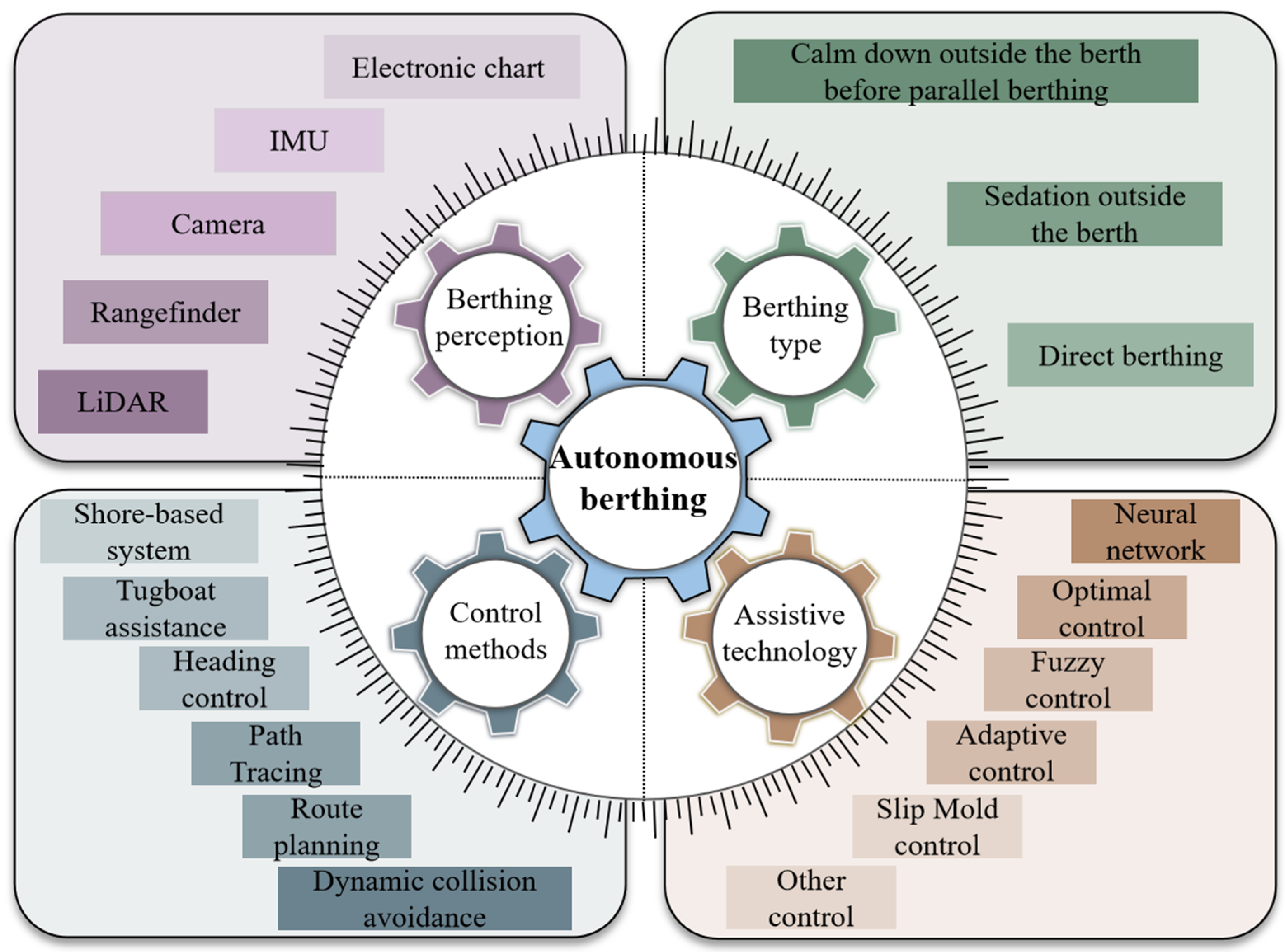
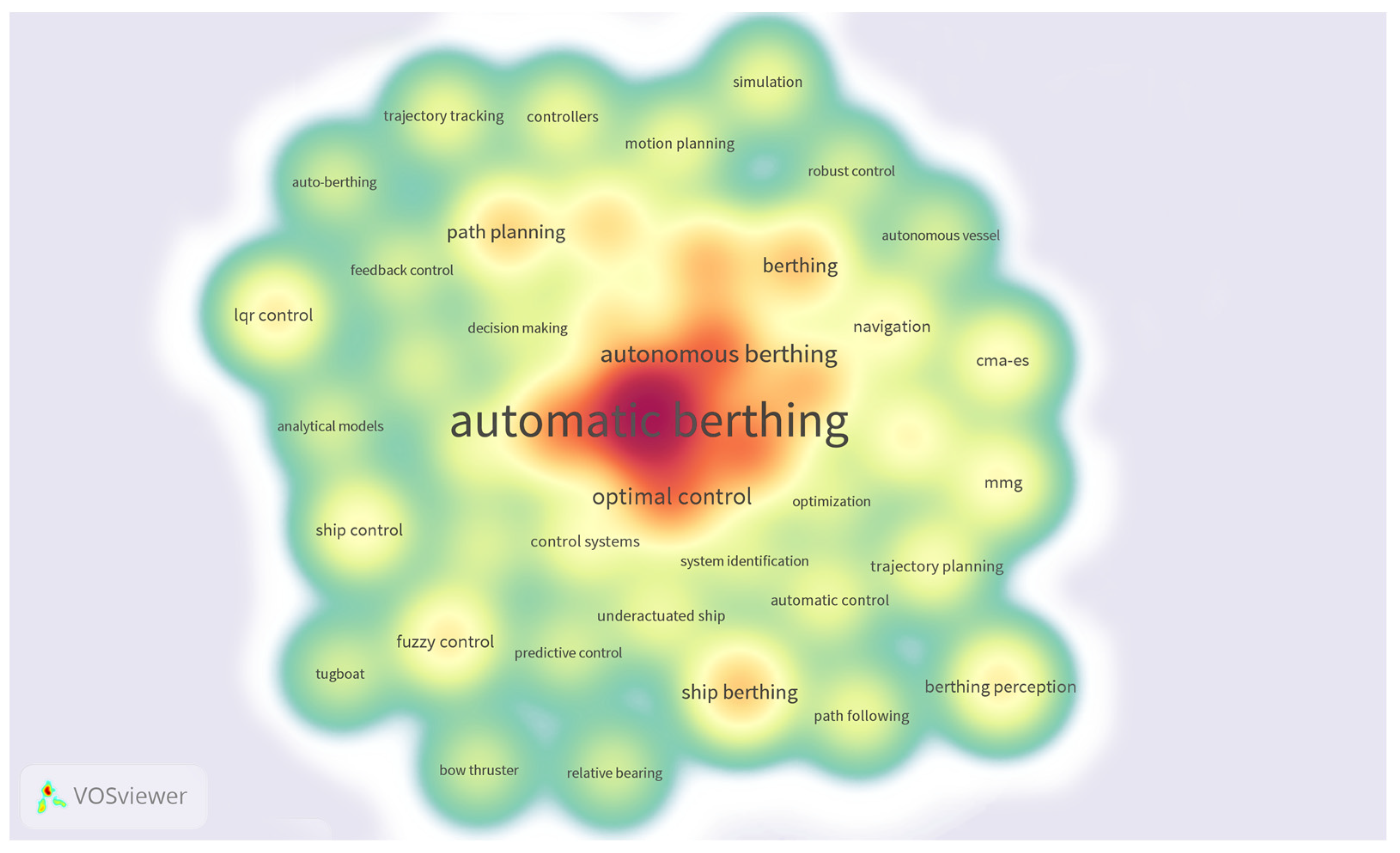
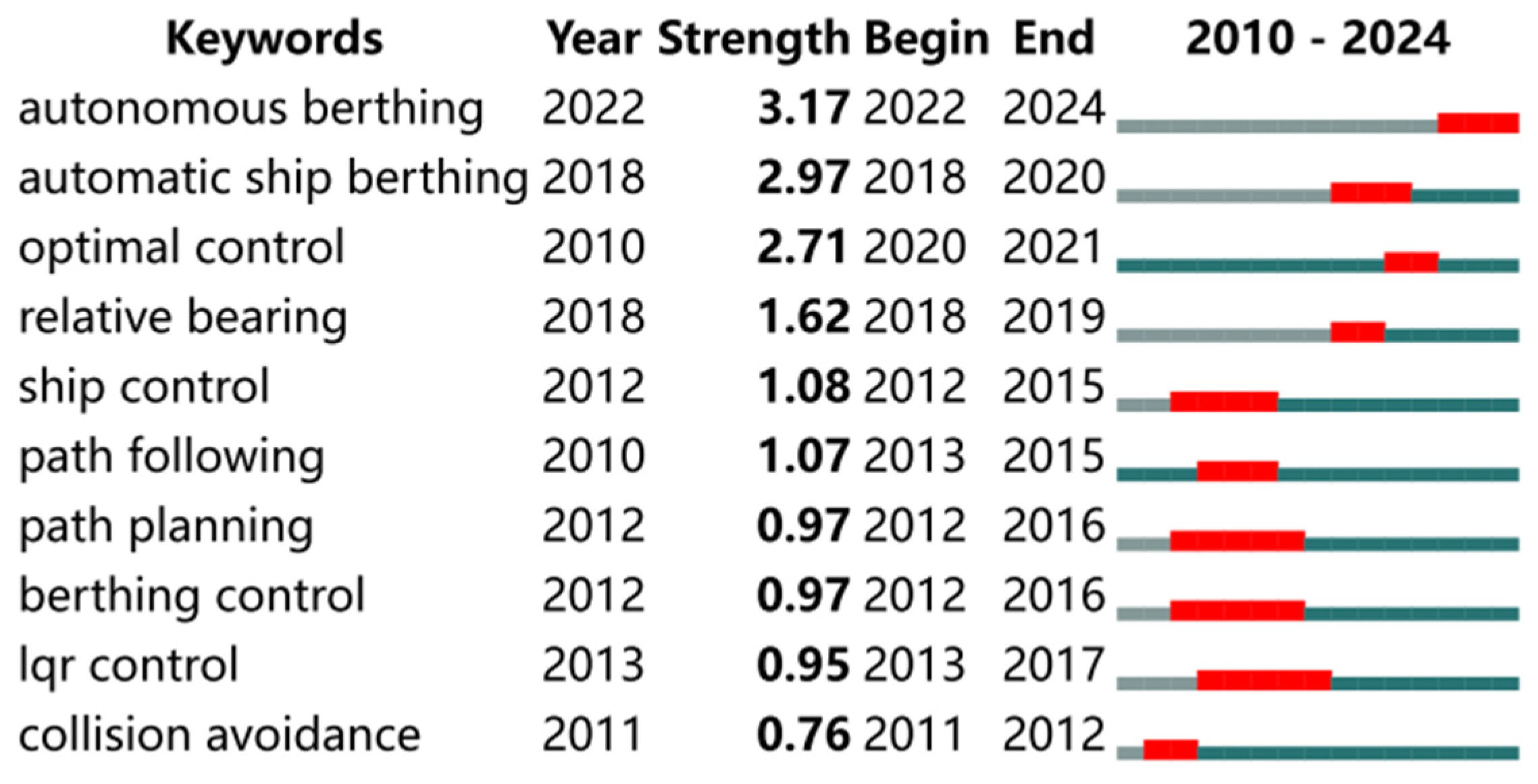
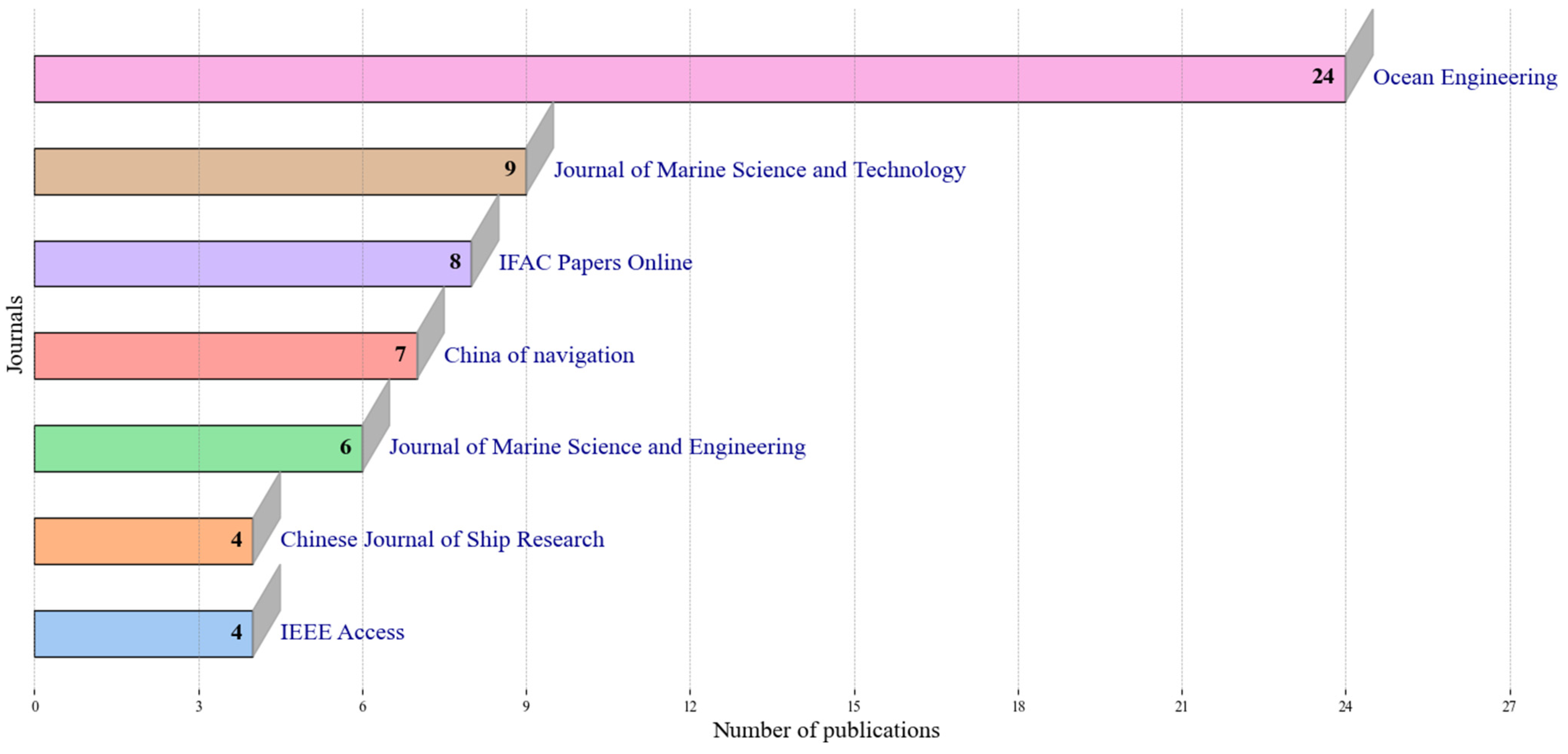


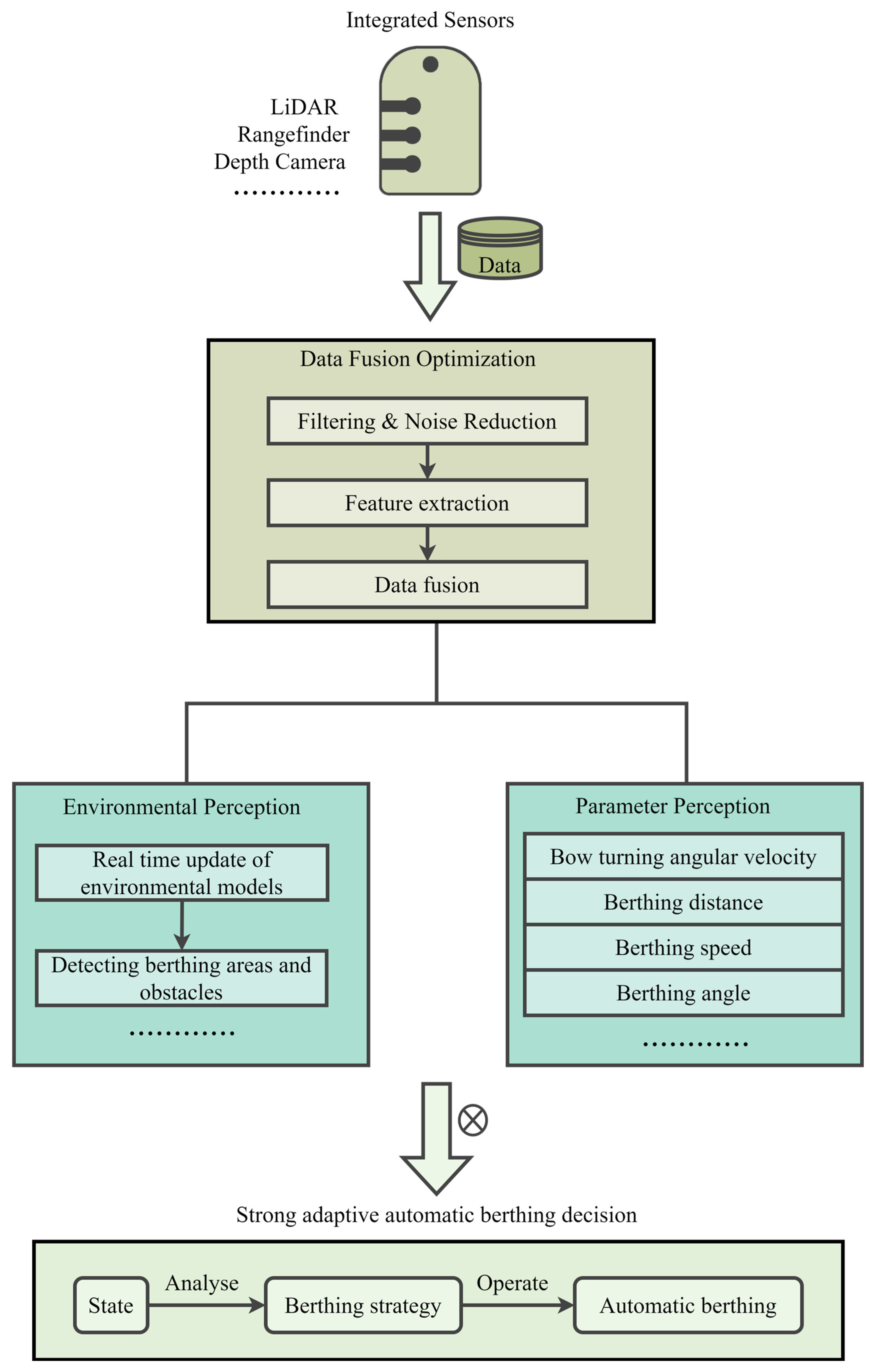


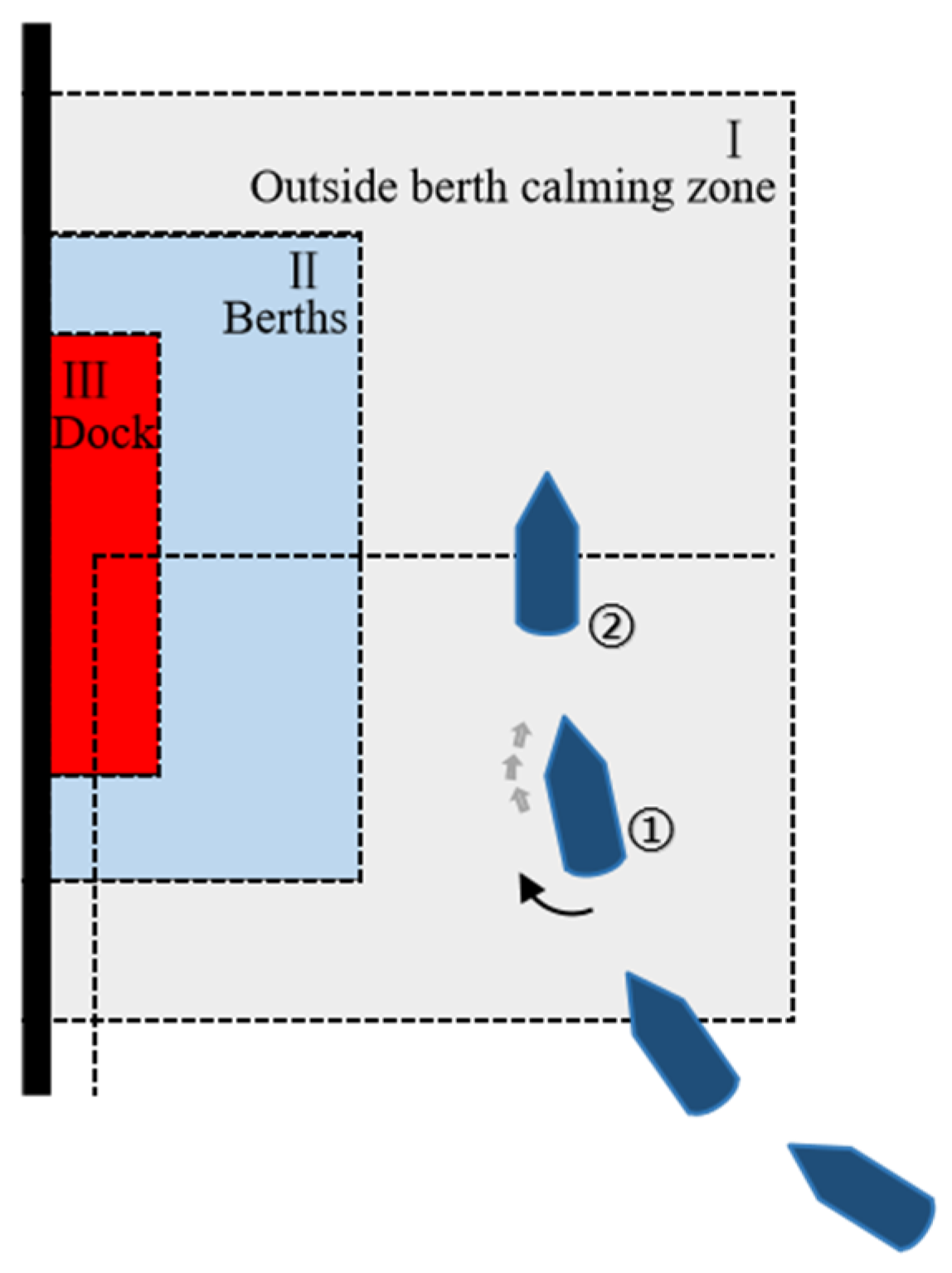
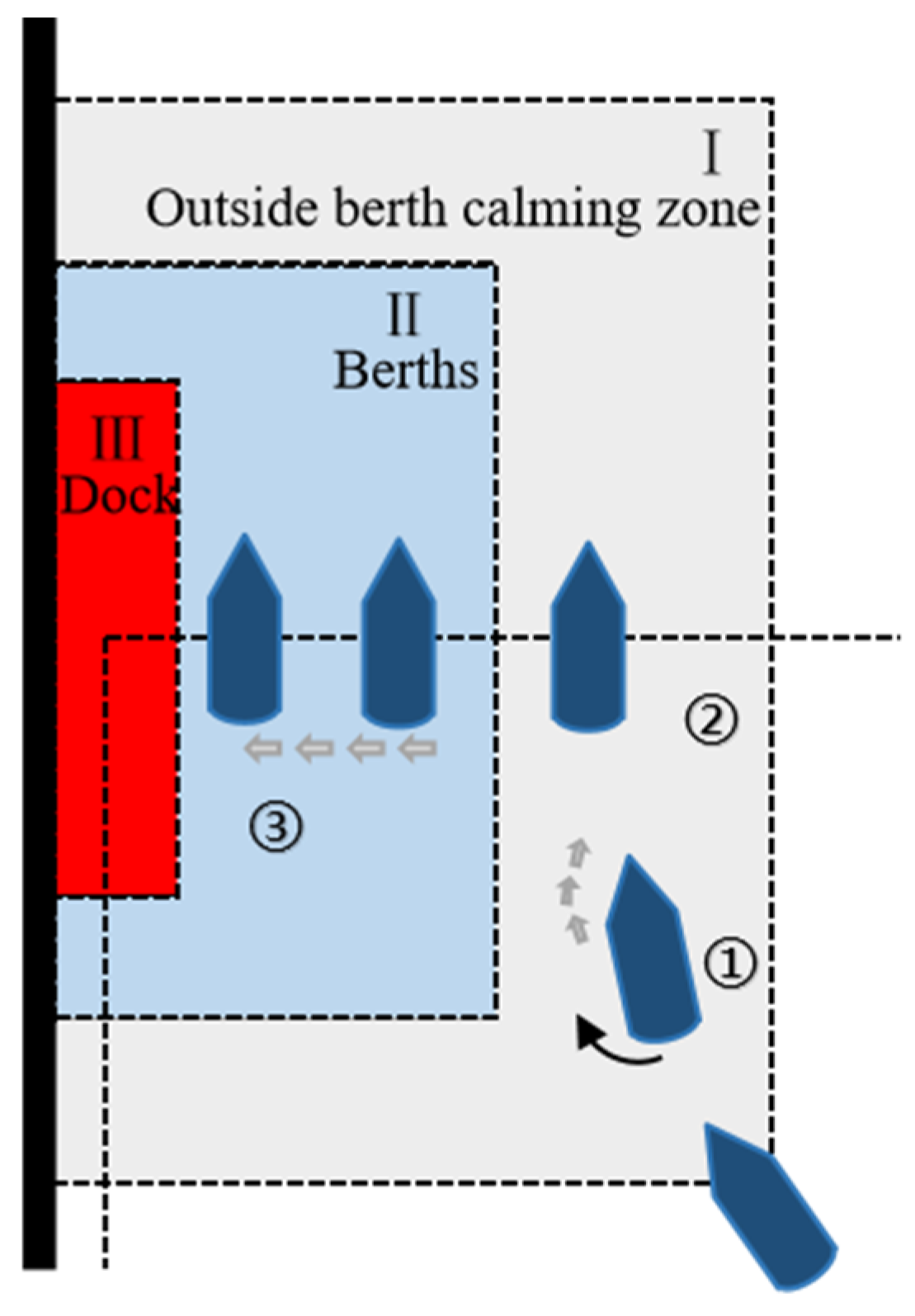




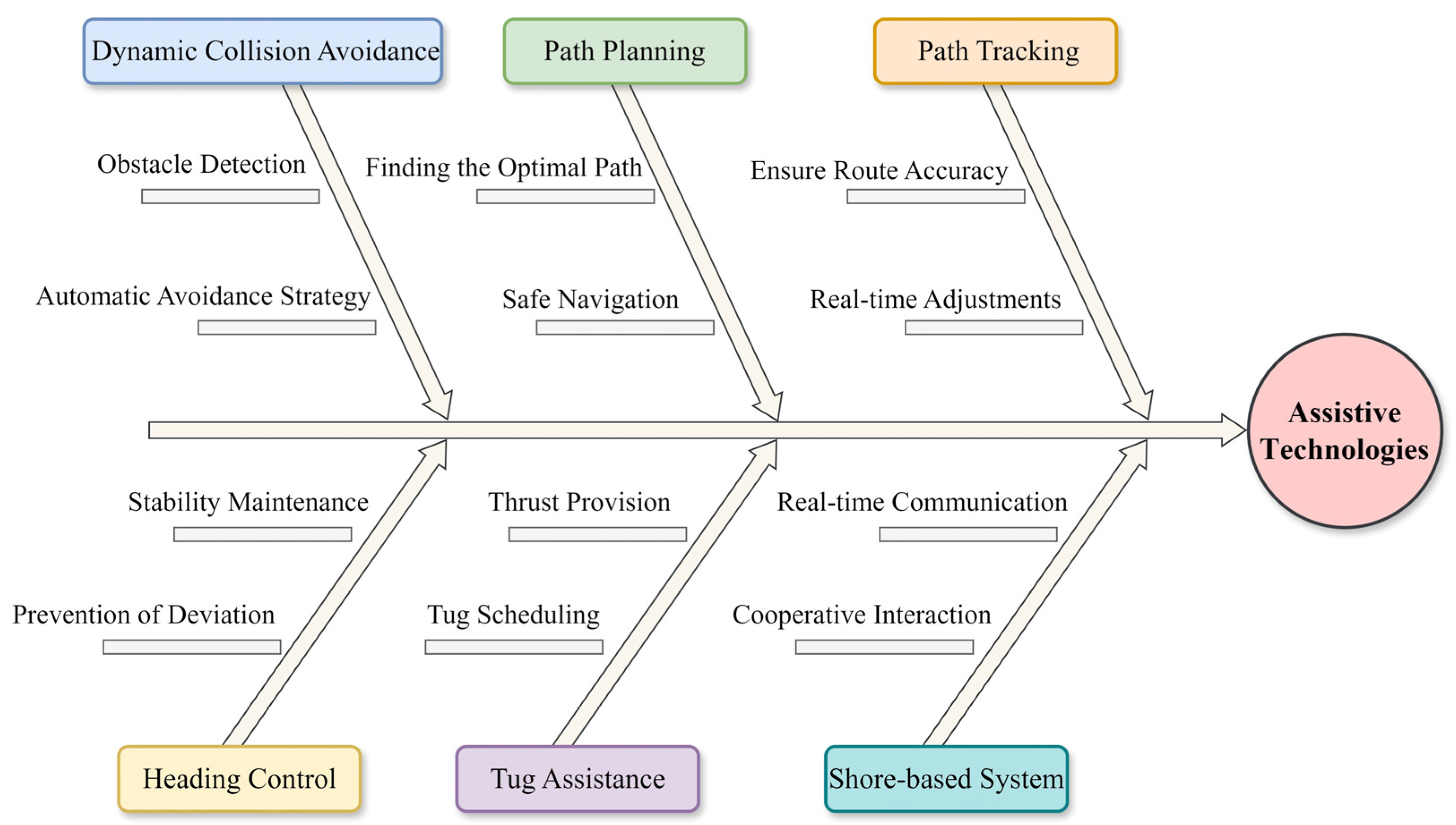
| Control Methods | Advantages | Disadvantages |
|---|---|---|
| Artificial Neural Networks | ① Ability to effectively deal with complex and nonlinear berthing dynamics. ② Ability to learn and adapt to the new environment. | ① Requires a lot of training data and time. ② Low real-time performance and large amount of computation. |
| Optimal Control | ① Provides optimal control strategy to minimise energy consumption or time. ② Suitable for berthing scenarios that require precise operation. ③ Clearly objective function-oriented. | ① High requirements for model accuracy. ② Complex calculation and sensitive to parameters. |
| Fuzzy Control | ① Strong robustness to system model uncertainty and external perturbations. ② Control rules are easy to understand. ③ Suitable for dealing with imprecise and fuzzy information in berthing. | ① System performance depends on the design of rules and is highly subjective. ② It is difficult to prove the stability of the system. |
| Adaptive Control | ① Automatically adjust control parameters to adapt to ship dynamics and environmental changes. ② Improve the adaptability and flexibility of the system. | ① Online parameter estimation is required. ② Stability and convergence are difficult to ensure. |
| Sliding Mode Control | ① Control system design is simple and easy to implement. ② Stable and robust in the presence of model uncertainty and external perturbations. ③ Fast response speed. | ① Sensitive to environmental and system noise, additional filtering measures may be required. ② Problems with vibration shaking. |
| Vintages | Researchers | Outcome | Verification Method |
|---|---|---|---|
| 2012 | Li [107] | A motion trajectory prediction algorithm for different ship states was established by combining the performance of the odometer and the mathematical model of MMG ships. | Simulation |
| 2016 | Vu et al. [108] | Application of PD control and LOS guidance to USV automated berthing. | Simulation |
| 2017 | Roubos et al. [109] | The berthing speeds and operating conditions of different types of ships at different berths were studied, and new probability distribution functions were established. | Live onboard experiment |
| 2017 | Yang et al. [110] | Description of an automated berthing system with mooring ropes using mooring devices on the upper deck of a vessel. | Simulation |
| 2020 | Liu [111] | The ship dynamic model with control quantities was used for optimisation using the interior point penalty function method to produce energy-optimal ship berthing trajectories and corresponding control quantities. | Live onboard experiment |
| 2020 | Meyer et al. [112] | A hierarchical control framework was proposed for complying with the reach-avoid-stay specification for nonlinear simulation control systems. | Simulation |
| 2021 | Wu et al. [113] | Mathematical modelling of USV manoeuvrability with bow and stern thrusters based on the MMG model. | Simulation |
| 2021 | Xiao et al. [114] | A berthing computational fluid dynamics (CFD) model was established, and the characteristics of speed field, pressure field, and vortex have been obtained under different speeds, wind directions, and quay wall distances. | Simulation |
| 2022 | Wang et al. [115] | Proposing an autonomous berthing method for unmanned boats based on berth shoreline detection to solve the natural berthing problem without guidance markers. | Simulation, live onboard experiment |
| 2023 | Lee et al. [116] | A two-phase, two-point boundary value problem (TPBVP) strategy was proposed. | Simulation |
| 2023 | Wakita et al. [117] | A reinforcement learning-based trajectory tracking controller training method was proposed to reduce the probability of collision between berthing and static obstacles. | Simulation |
| 2023 | Xue et al. [118] | Proposing a new asymmetric barrier Lyapunov function based on fixed-time ship berthing control under multi-state constraints. | Simulation |
| 2024 | Yang et al. [119] | Proposing a zero-space based self-resistant control allocation method to address multi-source disturbances in autonomous berthing. | Simulation |
| Vintages | Researchers | Evaluation Methodology |
|---|---|---|
| 2011 | Yin et al. [121] | Establishment of a ship berthing manoeuvre touchdown risk evaluation method by first-order ship manoeuver simulation and questionnaire survey. |
| 2013 | Xue et al. [122] | By analysing the indicators for assessing ship berthing manoeuvres, the affiliation values and weights of the assessment indicators were determined, and an assessment model was constructed. |
| 2016 | Chen et al. [123] | Establishment of a two-level evaluation index system and development of an automated intelligent evaluation system based on an improved genetic algorithm-backpropagation neural network. |
| 2022 | Jiang [124] | Based on the DBSCAN algorithm berth clustering analysis, a comprehensive evaluation model combining the TOPSIS model and entropy weight theory was established. |
| 2023 | Zhang [125] | Through a combination of DEMATEL, ANP, and grey correlation analysis, an evaluation index system covering four first-level indicators and 13 second-level indicators for safety, economy, efficiency, and intelligence was established. |
| 2023 | Zhang et al. [126] | Based on the principle of maximising the deviation, an autonomous berthing and de-berthing assessment model was established by combining the hierarchical analysis method, the CRITIC method, and the fuzzy comprehensive judgement method. |
| 2024 | Lin et al. [127] | Establishment of a real-time ship berthing risk assessment model based on the Improved Bossel Model, considering catastrophe and disaster factors. |
Disclaimer/Publisher’s Note: The statements, opinions and data contained in all publications are solely those of the individual author(s) and contributor(s) and not of MDPI and/or the editor(s). MDPI and/or the editor(s) disclaim responsibility for any injury to people or property resulting from any ideas, methods, instructions or products referred to in the content. |
© 2024 by the authors. Licensee MDPI, Basel, Switzerland. This article is an open access article distributed under the terms and conditions of the Creative Commons Attribution (CC BY) license (https://creativecommons.org/licenses/by/4.0/).
Share and Cite
Cai, J.; Chen, G.; Yin, J.; Ding, C.; Suo, Y.; Chen, J. A Review of Autonomous Berthing Technology for Ships. J. Mar. Sci. Eng. 2024, 12, 1137. https://doi.org/10.3390/jmse12071137
Cai J, Chen G, Yin J, Ding C, Suo Y, Chen J. A Review of Autonomous Berthing Technology for Ships. Journal of Marine Science and Engineering. 2024; 12(7):1137. https://doi.org/10.3390/jmse12071137
Chicago/Turabian StyleCai, Jiangliu, Guoquan Chen, Jian Yin, Chong Ding, Yongfeng Suo, and Jinhai Chen. 2024. "A Review of Autonomous Berthing Technology for Ships" Journal of Marine Science and Engineering 12, no. 7: 1137. https://doi.org/10.3390/jmse12071137
APA StyleCai, J., Chen, G., Yin, J., Ding, C., Suo, Y., & Chen, J. (2024). A Review of Autonomous Berthing Technology for Ships. Journal of Marine Science and Engineering, 12(7), 1137. https://doi.org/10.3390/jmse12071137







